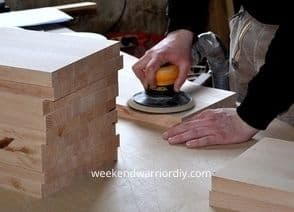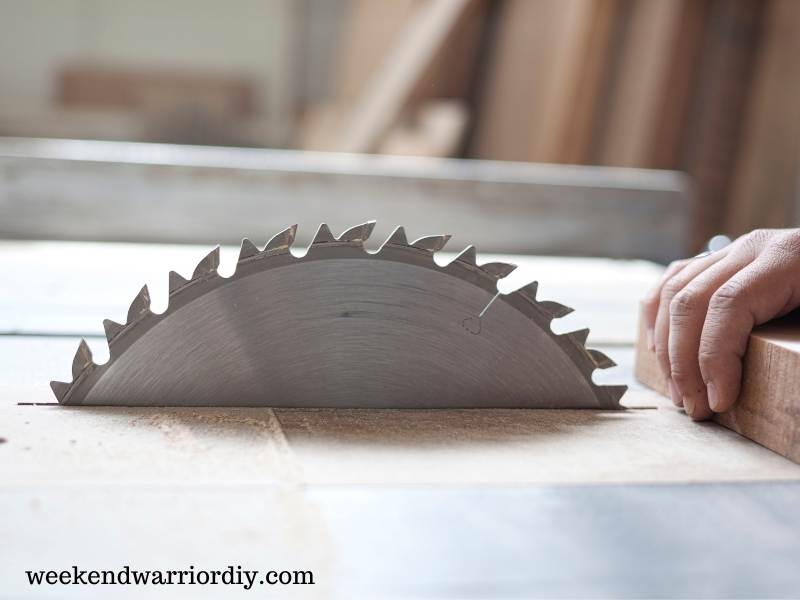Alright, so let’s talk woodworking, my friend. You know, it’s one of those crafts where every cut counts, right? And when it comes to woodworking, you can’t really go far without bumping into the good ol’ table saw. It’s like the bread and butter of any woodshop. But, man, oh man, there are just so many choices out there, it’s enough to make your head spin!
But fear not, because we’re diving headfirst into this sea of table saws together. Consider this guide your trusty life jacket as we navigate through the choppy waters of table saw options. We’re going to break it down, talk about what really matters, and help you make a decision that you won’t regret.
So, grab yourself a cup of coffee, settle into your favorite chair, and let’s get down to business. We’re about to embark on a journey to find the perfect table saw for you. Ready? Let’s do this! 🛠️
Understanding the Types of Table Saws
Alright, let’s break down the table saw game like a pro.
Benchtop Table Saws
Picture this: you’ve got a small workshop or you’re constantly on the move to different job sites. That’s where benchtop table saws come in clutch. They’re like the little engines that could – compact, lightweight, and easy to lug around. Perfect for those tight spaces or when you need to take your woodworking show on the road.
But here’s the catch: while they’re great for everyday cuts and DIY projects, they might struggle when you throw heavy-duty stuff their way. Think of them as the sprinters of the table saw world – quick and nimble, but not built for the marathon grind.
Contractor Table Saws
Now, if you’re serious about your woodworking game but still need some flexibility, contractor table saws are where it’s at. These bad boys are like the Goldilocks of the bunch – not too big, not too small, just right. They’ve got more oomph under the hood compared to benchtop models, so you can tackle those larger projects with ease. Plus, they’re built tough, with beefier construction that can handle the rough and tumble of the job site. Whether you’re a pro on the job or a serious hobbyist in the garage, contractor saws are your go-to for that perfect balance of power and portability.
Cabinet Table Saws
Now, if you’re ready to take things to the next level, it’s time to step up to the big leagues with cabinet table saws. These bad boys are like the heavyweight champions of the woodworking world – big, powerful, and built like a tank. With their massive, cabinet-style base, they’re as sturdy as they come, offering rock-solid stability and precision cuts that’ll make your jaw drop.
If you’re a pro woodworker or you’ve got some seriously demanding projects on your plate, cabinet saws are the way to go. They’re like the Ferrari of table saws – top-of-the-line performance that’ll leave you feeling like a woodworking rockstar.
So there you have it, my friend. Three different flavors of table saws, each with their own strengths and weaknesses. Now it’s up to you to pick the one that fits your needs like a glove. 🪚

Essential Features to Consider
Let’s dive deeper into the must-have features that can make or break your table saw experience.
Motor Power and Performance
Alright, let’s talk power – because when it comes to table saws, the motor is the MVP. Think of it as the beating heart of your saw, pumping out the energy needed to tackle even the toughest cuts. Now, here’s the deal: the higher the horsepower, the smoother your cuts are gonna be. That means less bogging down, fewer hiccups, and overall better performance, especially when you’re slicing through dense hardwoods or thick materials. So, if you’re planning on some serious woodworking magic, don’t skimp on the motor power.
Cutting Capacity and Blade Size
Now, let’s talk about size – because in the world of table saws, bigger is often better. The cutting capacity and blade size are like your saw’s secret weapons, giving you the versatility to tackle a wide range of projects with ease. Need to make some deep cuts? No problemo. Grab yourself a table saw with a larger blade, and you’ll be slicing through lumber like a hot knife through butter. And don’t forget about adjustable fences – they’re like the icing on the cake, adding that extra layer of precision and control to your cuts. So, when you’re shopping for a table saw, think big, think versatile, and don’t forget to check out those fancy adjustable fences.
Fence and Miter Gauge Quality
Last but not least, let’s talk about accuracy – because when it comes to woodworking, precision is everything. That’s where your table saw’s fence and miter gauge come into play. Picture this: you’re lining up your cut, aiming for perfection, and bam! Your fence slips, your miter gauge wobbles, and suddenly your masterpiece is looking more like a hot mess.
Not cool, right? That’s why it’s crucial to invest in a table saw with a rock-solid fence system and an accurate miter gauge. Look for features like micro-adjustability and smooth gliding mechanisms to ensure that every cut is on point. Trust me, your future woodworking projects will thank you for it.
So there you have it, folks – the essential features that’ll take your table saw game to the next level. From power and performance to cutting capacity and precision, these are the must-haves that’ll make woodworking a breeze. 🪚
Additional Considerations
Let’s take a closer look at some extra factors you should keep in mind when choosing your perfect table saw.
Dust Collection and Safety Features
Alright, let’s talk shop safety – because nothing ruins a woodworking session faster than a trip to the emergency room. First things first, keeping your workspace clean is key. I’m talking about dust collection systems that suck up those pesky wood particles before they have a chance to settle all over your shop (and your lungs).
Trust me, investing in a table saw with an effective dust collection system will not only keep your workspace tidy but also protect your health in the long run. But that’s not all – safety features like blade guards and riving knives are absolute must-haves.
They’re like your trusty sidekicks, working tirelessly to minimize hazards and keep your fingers where they belong – attached to your hands. So, when you’re shopping for a table saw, don’t skimp on safety. Your fingers will thank you.
Mobility and Portability
Now, let’s talk about mobility – because sometimes you gotta take your woodworking show on the road. Whether you’re a contractor hopping from job site to job site or just a DIY enthusiast with a penchant for woodworking adventures, portability matters. That’s where table saws with built-in wheels or folding stands come into play. They’re like the Swiss Army knives of the woodworking world, offering convenience and versatility in one neat package. So, if you’re constantly on the move or just short on space in your workshop, make sure to check out those portable table saw options. Trust me, your back will thank you when you’re lugging that saw from place to place.
So there you have it, folks – a couple of extra things to consider when you’re on the hunt for the perfect table saw. From keeping your workspace clean and safe to making sure your saw is as mobile as you are, these factors can make all the difference in your woodworking experience. 🪚
Budget Considerations
While it’s tempting to opt for the cheapest option, investing in a quality table saw is crucial for long-term success in woodworking. Assess your budget carefully and prioritize features that align with your needs and aspirations.
Understanding the Comparison Table:
This comparison table (below) provides a comprehensive overview of the key features of benchtop, contractor, and cabinet table saws, helping you make an informed decision based on their specific needs and preferences.
Portability:
Benchtop Table Saw: These are highly portable and compact, making them ideal for those who need to move their saw around frequently or have limited space.
Contractor Table Saw: They offer moderate portability, suitable for job sites or workshops where mobility is important but not critical.
Cabinet Table Saw: These are bulkier and less portable, typically found in professional workshops where mobility is less of a concern.
Power:
Benchtop Table Saw: Offers limited power, suitable for light to moderate woodworking tasks.
Contractor Table Saw: Provides moderate to high power, making it suitable for a wide range of woodworking projects.
Cabinet Table Saw: Offers high power, ideal for heavy-duty woodworking tasks and professional use.
Cutting Capacity:
Benchtop Table Saw: Has limited cutting capacity, suitable for small to medium-sized projects.
Contractor Table Saw: Offers medium to large cutting capacity, allowing for versatility in project sizes.
Cabinet Table Saw: Provides a large cutting capacity, suitable for large and heavy-duty projects.
Precision:
Benchtop Table Saw: Offers average precision, suitable for basic woodworking tasks.
Contractor Table Saw: Provides good precision, allowing for accurate and consistent cuts.
Cabinet Table Saw: Offers excellent precision, ideal for intricate woodworking tasks and precise cuts.
Suitability:
Benchtop Table Saw: Ideal for DIY projects and small workshops.
Contractor Table Saw: Suitable for medium to large projects, both in workshops and on job sites.
Cabinet Table Saw: Designed for professional workshops and heavy-duty projects.
Price Range:
Benchtop Table Saw: Typically low to moderate in price.
Contractor Table Saw: Moderate to high price range.
Cabinet Table Saw: Usually falls in the higher price range due to its advanced features and capabilities.
Dust Collection System:
Benchtop Table Saw: Often basic or optional dust collection systems.
Contractor Table Saw: Moderate effectiveness in dust collection.
Cabinet Table Saw: Excellent dust collection capabilities, keeping the workspace clean and safe.
Safety Features:
Benchtop Table Saw: Basic safety features.
Contractor Table Saw: Standard safety features, ensuring safe operation.
Cabinet Table Saw: Advanced safety features for enhanced protection during use.
Blade Size:
Benchtop Table Saw: Smaller blade size, suitable for lighter cutting tasks.
Contractor Table Saw: Medium to large blade size, offering versatility for different types of cuts.
Cabinet Table Saw: Large blade size, ideal for heavy-duty cutting tasks and precision work.
Recommended For:
Benchtop Table Saw: Recommended for beginners and hobbyists.
Contractor Table Saw: Suitable for intermediate to advanced woodworkers.
Cabinet Table Saw: Ideal for professional woodworkers and those handling heavy-duty projects.
And for those of you that prefer to look at this type of information in a table.
| Feature | Benchtop Table Saw | Contractor Table Saw | Cabinet Table Saw |
| Portability | Highly portable and compact | Moderately portable | Bulky and less portable |
| Power | Limited power | Moderate to high power | High power |
| Cutting Capacity | Limited cutting capacity | Medium to large capacity | Large cutting capacity |
| Precision | Average precision | Good precision | Excellent precision |
| Suitability | DIY projects, small workshops | Medium to large projects, job sites | Professional workshops, heavy-duty projects |
| Price Range | Low to moderate | Moderate to high | High |
| Dust Collection System | Often basic or optional | Moderate effectiveness | Excellent dust collection |
| Safety Features | Basic safety features | Standard safety features | Advanced safety features |
| Blade Size | Smaller blade size | Medium to large blade size | Large blade size |
| Recommended For | Beginners, hobbyists | Intermediate to advanced woodworkers | Professional woodworkers |

Conclusion
Let’s talk about why choosing the right table saw is such a big deal in the world of woodworking.
Importance of Choosing the Right Table Saw
Alright, listen up, fellow woodworkers – choosing the right table saw is like picking the perfect tool for the job. It’s not just about getting any old saw and hoping for the best. No sir, it’s about finding that one saw that’s gonna take your woodworking game to the next level.
Influence on Project Quality and Efficiency
Here’s the deal: the table saw you choose can make or break your projects. Seriously, it’s that important. A good saw will make your cuts smoother, your edges cleaner, and your projects overall more polished. But pick the wrong one, and you could end up with wonky cuts, uneven edges, and a whole lot of frustration. Ain’t nobody got time for that.
Understanding Types and Essential Features
So, how do you make sure you’re picking the right saw for the job? Simple – by understanding the different types of table saws and what features to look out for. From benchtop to contractor to cabinet saws, each type has its own strengths and weaknesses. And don’t even get me started on essential features like motor power, cutting capacity, and safety features. These are the bread and butter of any good table saw, and understanding them is key to making the right choice.
Weighing Factors and Seeking Expert Advice
But hey, if all this table saw talk has got your head spinning, don’t worry – you’re not alone. Sometimes, it’s hard to know where to start, and that’s okay. That’s where seeking expert advice comes in handy. Whether it’s chatting with fellow woodworkers, consulting with professionals at your local hardware store, or even reaching out to online forums, don’t hesitate to ask for help. A little expert advice can go a long way when it comes to picking the perfect table saw for your needs.
So, there you have it, folks – choosing the right table saw is a big deal, but armed with the right knowledge and a little expert advice, you’ll be slicing and dicing your way to woodworking glory in no time. Happy sawing! 🪚
FAQs
Alright, let’s clear up some common questions about table saws.
1. What is the difference between a benchtop and cabinet table saw?
So, here’s the lowdown: benchtop table saws are like the little siblings of the woodworking world. They’re compact, lightweight, and perfect for small workshops or on-the-go jobsites. Cabinet saws, on the other hand, are the heavy hitters. They’re bigger, bulkier, and built like tanks, offering superior power and precision. Think of benchtop saws as the sprinters – quick and nimble – and cabinet saws as the marathon runners – sturdy and dependable.
2. How important is motor power when choosing a table saw?
Listen up, folks – motor power is the name of the game when it comes to table saws. It’s like the engine under the hood, powering your cuts and keeping things running smoothly. When you’re working with dense materials like hardwoods, you need all the horsepower you can get for those clean, precise cuts. So, don’t skimp on motor power – go for higher horsepower ratings for smoother cuts and increased efficiency.
3. Are safety features like blade guards and riving knives necessary?
Absolutely, my friend. Safety first, always. Blade guards and riving knives are like your trusty sidekicks, working tirelessly to keep you safe in the workshop. They’re crucial for minimizing the risk of accidents and injuries, so always prioritize saws equipped with adequate safety mechanisms. Your fingers will thank you.
4. Can I use a table saw for cutting materials other than wood?
While table saws are kings of the woodcutting world, they can also handle other materials with the right blade and precautions. Need to slice through some plastic, aluminum, or laminate? No problemo. Just make sure you swap out the blade and follow proper safety protocols, and you’ll be good to go.
5. What should I do if I’m unsure about which table saw to choose?
Hey, we’ve all been there – standing in front of rows of table saws, scratching our heads and wondering which one is the right fit. When in doubt, don’t be afraid to ask for help. Reach out to experienced woodworkers, chat with professionals at your local hardware store, or hop online and seek advice from woodworking forums. Trust me, a little expert guidance can go a long way in helping you find the perfect table saw for your needs.
So, there you have it, folks – your burning questions about table saws, answered. Now, go forth and saw with confidence! 🪚



